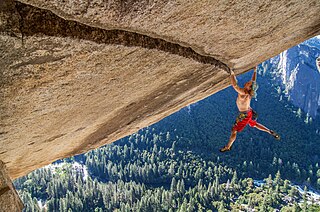
Climbing is the activity of using one's hands, feet, or other parts of the body to ascend a steep topographical object that can range from the world's tallest mountains to small boulders. Climbing is done for locomotion, sporting recreation, for competition, and is also done in trades that rely on ascension, such as rescue and military operations. Climbing is done indoors and outdoors, on natural surfaces, and on artificial surfaces

Mountaineering, mountain climbing, or alpinism is a set of outdoor activities that involves ascending mountains. Mountaineering-related activities include traditional outdoor climbing, skiing, and traversing via ferratas that have become sports in their own right. Indoor climbing, sport climbing, and bouldering are also considered variants of mountaineering by some, but are part of a wide group of mountain sports.
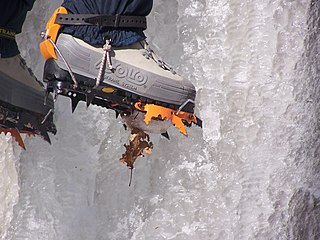
A crampon is a traction device attached to footwear to improve mobility on snow and ice during ice climbing. Besides ice climbing, crampons are also used for secure travel on snow and ice, such as crossing glaciers, snowfields and icefields, ascending snow slopes, and scaling ice-covered rock.

An ice axe is a multi-purpose hiking and climbing tool used by mountaineers in both the ascent and descent of routes that involve snow, ice, or frozen conditions. Its use depends on the terrain: in its simplest role it is used like a walking stick, with the mountaineer holding the head in the center of their uphill hand. On steep terrain it is swung by its handle and embedded in snow or ice for security and an aid to traction. It can also be buried pick down, the rope tied around the shaft to form a secure anchor on which to bring up a second climber, or buried vertically to form a stomp belay. The adze is used to cut footholds, as well as scoop out compacted snow to bury the axe as a belay anchor.

Glossary of climbing terms relates to rock climbing, mountaineering, and to ice climbing.

Ice climbing is a climbing discipline which involves ascending routes that consist only of frozen water. To ascend the route, the ice climber uses specialist equipment, particularly double ice axes and rigid crampons. To protect the route, the ice climber uses steel ice screws that require skill to employ safely and rely on the ice holding firm in any fall. Ice climbing routes can vary significantly by type, and include seasonally frozen waterfalls, high permanently frozen alpine couloirs, and large hanging icicles.

Ski mountaineering is a skiing discipline that involves climbing mountains either on skis or carrying them, depending on the steepness of the ascent, and then descending on skis. There are two major categories of equipment used, free-heel Telemark skis and skis based on Alpine skis, where the heel is free for ascents, but is fixed during descent. The discipline may be practiced recreationally or as a competitive sport.
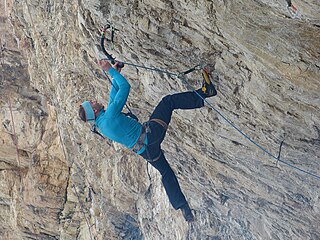
Dry-tooling is a form of mixed climbing that is performed on bare, ice-free, and snow-free, routes. As with mixed climbing, the climber uses ice axes and crampons to ascend the route, but uses only rock climbing equipment for protection; many modern dry-tooling routes are now fully bolted like sport climbing routes. Many indoor ice climbing competitions are held on non-ice surfaces and are effectively dry-tooling events.

Black Diamond Equipment is a manufacturer of equipment for climbing, skiing, and mountain sports, based in Utah, United States. The company also has a global office in Innsbruck, Austria. The company is owned by Clarus Corporation, which also owns Pieps, ClimbOn! Skincare, and Sierra Bullets.
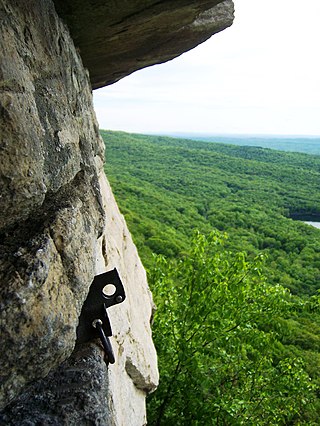
Clean climbing is rock climbing techniques and equipment which climbers use in order to avoid damage to the rock. These techniques date at least in part from the 1920s and earlier in England, but the term itself may have emerged in about 1970 during the widespread and rapid adoption in the United States and Canada of nuts, and the very similar but often larger hexes, in preference to pitons, which damage rock and are more difficult and time-consuming to install. Pitons were thus eliminated in North America as a primary means of climbing protection in a period of less than three years.

A piton in big wall climbing and in aid climbing is a metal spike that is driven into a crack or seam in the climbing surface using a climbing hammer, and which acts as an anchor for protecting the climber against the consequences of falling or to assist progress in aid climbing. Pitons are equipped with an eye hole or a ring to which a carabiner is attached; the carabiner can then be directly or indirectly connected to a climbing rope.

Yvon Chouinard is an American rock climber, environmentalist, philanthropist and outdoor industry businessman. His company, Patagonia, is known for its commitment to protecting the environment. He was named one of the 100 most influential people in the world by Time magazine in 2023.

Premana is a comune (municipality) in the Province of Lecco in the Italian region Lombardy, located about 70 kilometres (43 mi) northeast of Milan and about 20 kilometres (12 mi) north of Lecco. As of 31 December 2004, it had a population of 2,285 and an area of 33.7 square kilometres (13.0 sq mi). Premana has a long tradition in iron and steel working and is a centre of production for scissors and other cutting utensils, such as the safety razors from the traditional Italian brand Fatip, which have been handcrafted in Premana since the 1980s.
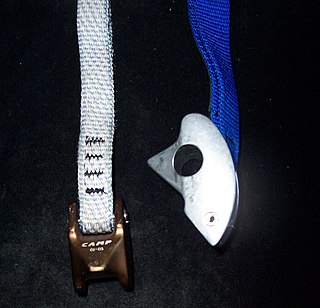
A tricam is a type of climbing protection equipment. A versatile nut/cam hybrid, the Tricam was invented by Greg Lowe in 1973, and came to market in 1981. They are currently manufactured by C.A.M.P. of Premana Italy.
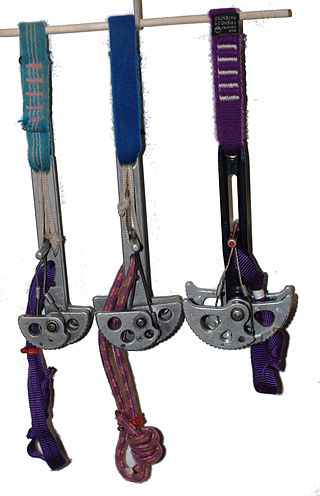
Wild Country is a major manufacturer of rock climbing equipment, and is most noted for introducing the Friend, a spring-loaded camming device. The company is based in Tideswell in the English Peak District, close to some of the UK's most popular climbing areas.
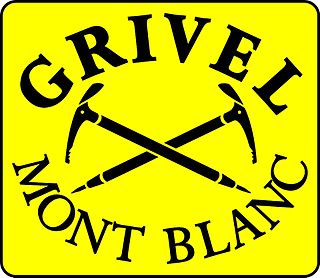
Grivel Srl is a company that produces tools and equipment for alpinism, climbing, and outdoor activities. It exports to 26 countries. All the personal safety products, ice axes, crampons, pitons, helmets are produced in Italy. The company has been certified GS TUF since 1992, ISO 9001 since 1996, ISO 1400 since 2004.

Mixed climbing is a climbing discipline used on routes that do have not enough ice to be pure ice climbs, but are also not dry enough to be pure rock climbs. To ascend the route, the mixed climber uses ice climbing tools, but to protect the route, they use traditional or sport rock climbing tools. Mixed-climbing can vary from routes with deep layers of ice and some exposed rock sections to routes that have no deep layers of ice, but where the rock is still covered in ice and/or snow.

Thomas "Tom" M. Frost was an American rock climber known for big wall climbing first ascents in Yosemite Valley. He was also a photographer and climbing equipment manufacturer. Frost was born in Hollywood, California, and died in Oakdale, California.

An alpine route or high alpine route is a trail or climbing route through difficult terrain in high mountains such as the Alps, sometimes with no obvious path. In the Alps, the various Alpine clubs define and mark an alpine route, also called alpinweg or alpinwanderweg. More generally, the term is used for routes of crossing the Alps, such as Roman crossings and Napoleon crossing the Alps. It is also used to describe routes in other mountains with alpine conditions.

The Imperial-Royal Mountain Troops were founded in 1906 as part of the Austrian Landwehr, the territorial army of the Cisleithanian half of the Austro-Hungarian Empire. As a result, the abbreviation "k.k." was used and not "k.u.k." which would have implied a connexion with the Hungarian half of the Empire.





















